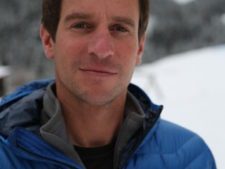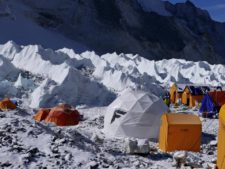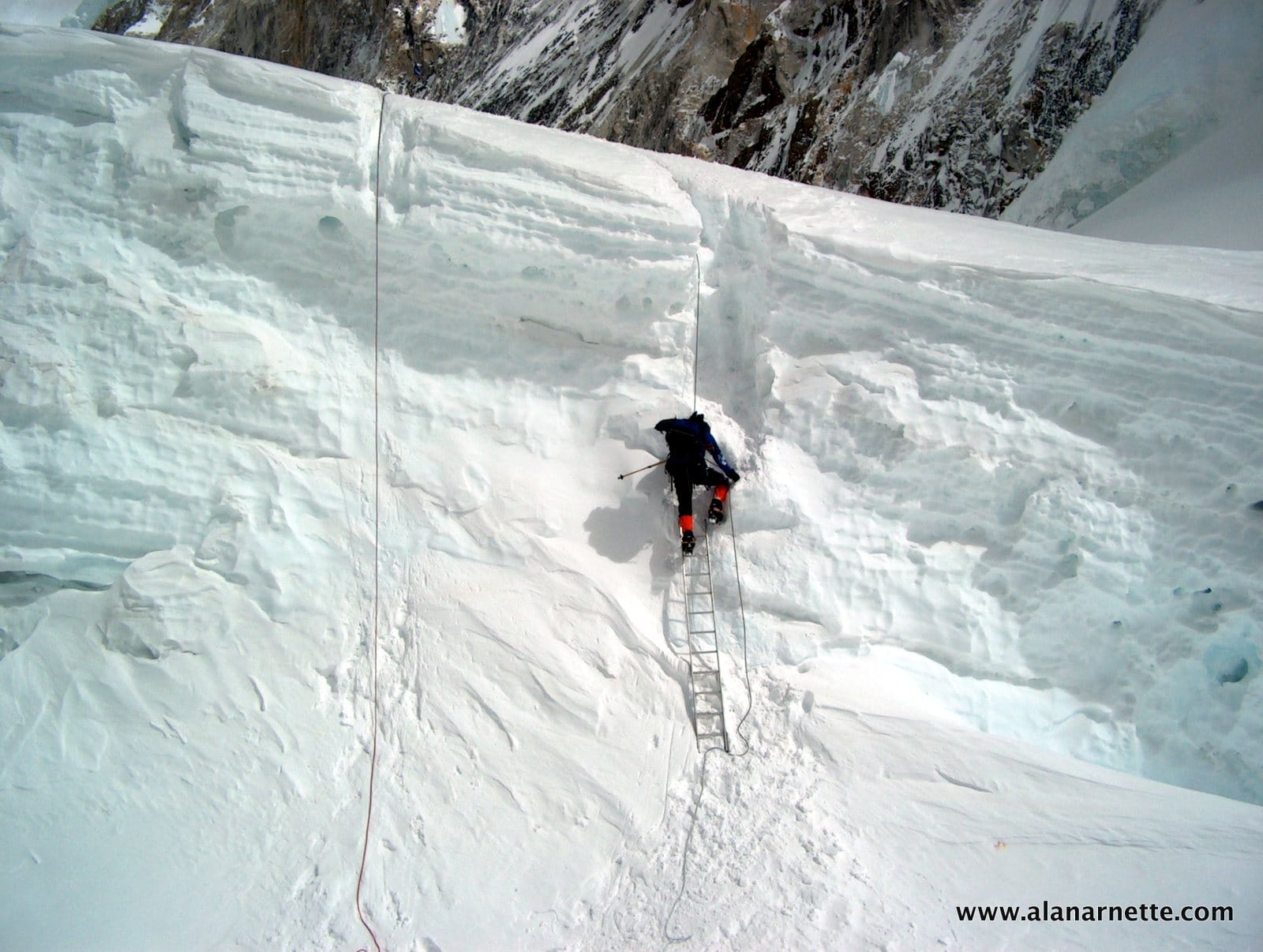Before I get to an interview with a new face on Everest, a quick update on the summit push news from the mountain. The ropes were fixed to the summit from the Nepal side on Wednesday, May 11. The Sherpas were from Adventure Consultants, Ascent Himalaya, Asian Trekking, Arun Trek, Himalayan Ascent, Himalayan Expedition, International Mountain Guides, Madison Mountaineering and Seven Summits Trek according to Russell Brice, Himex.
This opens the door for the upcoming short summit window. I still expect to see over 100 climbers (members and Sherpas) on this first wave. Look for summits from the Nepal side early Sunday morning, May 15, 2016 – Nepal time.
Climber Colin O’Brady reported that a small avalanche in the Khumbu Icefall stopped progress for 3 hours today but is fixed now – there were NO injuries
North Summit Push?
7 Summits Club reported an abbreviated summit push apparently not waiting for the CTMA to fix the ropes to the summit:
Our impulse to move sharply upward was stopped by snow and the lack of a fixed ropes. But this, in some sense, the audit showed the willingness of absolutely all the participants for the assault at any moment.
Information from the Chinese changed about when they will finish fixing ropes to the summit. So there are many reasons to be fidgety. We are encouraged by the fact that no one in our team use it. Everyone understands that patience– it is a part of successful expedition.
Mountain Rescue
For some excellent news, the two Slovakian climbers Vladimír Štrba and Zoltán Pál who were trapped on the Southwest Face after being hit by a snow avalanche have been rescued by four Sherpas hosted by Seven Summits Treks. They are Mingma Gabu, Lakpa Thinduk, Ngima Dorchi and Ngima Wangdi.
I’m sure this was filmed as there were helicopters attempting a rescue the prior day but stopped due to bad weather. A television crew for the Travel Channel had set up a team named ‘Everest Air’ as sort of a 911 on the mountains and were aggressively inserting themselves into many events, camera in hand. The team was hosted by Seven Summits Treks.
In the Himalayan Times, one of Seven Summits owners, Mingma Sherpa used this event as a platform to answer critics that low cost outfits like his lack experience. They are the largest team on Everest this year with 45 members and have had twice that many in previous years reportedly charging as little as $20,000 per climber. He said:
“It is an answer to all commentators, especially to the international expedition operators, who explicitly raised questions over the capability of Nepali companies including Seven Summit which started handling a large number of expeditions on its own.“
The Sherpas climbed above the two climbers, secured by an ice screw on the icy slope to set up a fixed rope. They were lowered to a safer spot of the slope and then descend to Camp 2. The injuries were described as minor and involved the eye of one climber. They were evacuated by helicopter from Camp 2 to Kathmandu.
Interview with Lucas Furtenbach

While on my Lhotse attempt, our camp was located next to the camp of an impressive and confident young Austrian, Lucas Furtenbach owner of Furtenbach Adventures. This was his first guided trip to Everest after establishing himself in Europe for the past 18 years. I had a chance to sit down with the 38 year-old from Innsbruck in his domed community tent for a talk, his young members all around working on their computers.
Lucas employees 15 European IFMGA Guides and merged in 2014 with his business partner Harald Fichtinger who specializes in heliskiing and a mountaineering school. He also runs an outdoor film production company and had several cameras to record their Everest climb this year.
They have run trips to all seven continents, including six 8000 meters peaks and to Greenland, Patagonia, Georgia and more.

Lucas was a bit surprised as what he had seen on his first trip to Everest. He told me today via email that they are waiting for the second weather window as this first one does not seem to be to stable. His weather sources are forecasting heavy snowfall for May 12 & 13 and high winds from May 14 to 17.
They are using Iceland-Trekking for their logistics and base camp services. Please meet Lucas Furtenbach:
Q: What is your experience on 8000 meters mountains?
Overall success rate for members on 8000m mountains above basecamp is around 70%. But we do not work with success rates as it is not always easy to communicate. K2 for example – we had to abort the climb due to safety concerns, success rate 0 would destroy our overall success rate. Anyway, we will openly communicate our statistics on Everest from our first season on as we think possible members need and want that.
Q: What makes Furtenbach Adventures different from other guide companies working in the Himalayas?
We follow our own acclimatization program. This involves altitude tents for 6 weeks at home and further acclimatization on other peaks than the final expedition goal. This program was developed in cooperation with Martin Burtscher, MD – researcher at University of Innsbruck and expert in high altitude medicine and acclimatization. This program makes the expedition duration shorter, makes members feel better during acclimatization with less symptoms of altitude, raises success rate and makes the dangerous prevention use of drugs like diamox or even dexamethason obsolete. And on Everest of course it means less rotations through the icefall. At our current expedition we have only 1 rotation before summit push but still 4 nights at camp 2 (we skip camp 1) and one night at camp 3 (we think this night is essential for safety and success. And if acclimatization process done right the night is not hard at all).
We only work with European IFMGA guides on our expeditions. This is the highest qualification level worldwide and ensures safety on the mountain and in critical and / or emergency situations.
We only use latest high end equipment. This involves the latest Summit Oxygen system with masks, regulators AND bottles. The newest Summit Oxygen bottles are almost 1 kg lighter than any other oxygen bottle on the market.
We pay our sherpa staff higher salary and bonuses than most other outfitters. All our staff is insured and equipped with same equipment as our members. We try to provide a high class of comfort and genuine food at basecamp. This helps to recover better when at basecamp.
Q: You use pre-acclimatization tents. Can you quantify how it makes a difference?
For Everest acclimatization tents for 6 weeks prior departure are included in the price. For other expeditions it is available at a surcharge of US$ 600. Tents are available in different sizes and are set up ideally on the bed in the sleeping room and used for sleeping. We can even provide double tents for couples. So it will not take members`s time and not too much effort. In overall it shortens an expedition duration for 10-14 days. But much more important is the fact that it will give you more safety in preventing altitude sickness, HAPE and HACE and it makes the very dangerous prevention use of drugs like dexamethasone obsolete.
Q: Do you use European guide on your Himalayan climbs?
Yes, only European IFMGA guides.
Q: You use Iceland Trekking as your Nepal local agency. Do you know where they hire their Sherpas and do you know if they pay them at the market rtes, provide insurance and gear allowances?
I work with Iceland Trekking in Nepal since 18 years. They already worked for Hans Kammerlander and Reinhold Messner 20 years ago and have a strong connection to Austria. We hire our Sherpas from Khumbu, lower Khumbu and from Makalu region. As per my experience some of the strongest Sherpas are from Makalu. We pay them over market rates and provide available insurance for them. My personal opinion is that Sherpas are our true capital. They are the heroes here and without them we can`t do nothing (as a commercial operator). So that is why I want to keep them happy working for us.
Q: 2016 is your first trip to Everest. Why this year after the difficulty of the last two years?
I never really wanted to operate Everest. This changed after I have seen a lot of badly run expeditions in the Himalayas from well known big operators. I have seen guides that behaved really, really bad and were guiding like shit. I have seen western guides leaving their members alone. I wanted to do things better. And finally we got an offer for a film project on Everest. That was the point where I said – ok, that is a chance to show that there is maybe a new generation of Expedition operators that is trying to make things on Everest different. Make things better and change old structures. 5 out of 14 8000m peaks were first climbed by Austrians. We have a long tradition in himalayan climbing and lots of experience. We know how:-)
Q: Will you expand on your comment “I have seen a lot of badly run expeditions in the Himalayas from well known big operators”
it is not my intention to piss off any other operator so that is why I did not specify the names of other operators. Howsoever I made really bad experiences for example with European companies, Nepali low budget operators. And of course there are always these special members from the well-known Western operators that wear crampons for the first time in basecamp and learn to abseil at basecamp.
These people really shouldn’t be on an 8000m peak. Not at all. This should be clear since 1996 but obviously it is not. I would never accept such members. No matter how much they pay. This year I refused 6 Everest members because they are too unexperienced. Thats a loss of € 250.000 revenue. But I have peace of conscience. For all bad experiences I have photo / video material proofing what I am telling.
Some of that material is so “hot” that I could easily destroy the companies reputation completely. I am not doing this of course. Just one example – with one company I had an almost 6 year long dispute. They are still afraid that I publish my material showing their “safety” standards for route fixing material or their IFMGA guide leaving a member alone at high camp just because the guide wanted to be in comfortable basecamp. We rescued this member one day later with beginning HAPE, completely exhausted and helpless, not able to walk anymore ( btw – same we did on Island peak 2 weeks ago with members from a Nepali low budget operators.). Sad but I can tell many stories like this…
Q: How many members do you have?
2016 we have 6 members, 2 guides, 1 film crew. 2 members already left expedition before reaching basecamp because of serious health problems (not altitude related). On Everest or K2 I would always limit the group size to 6 members maximum due to safety reasons.
Q: How is it going? How high have you reached on the Nepal side?
So far everything going very well. We were the first team to spend a night at camp 3 on April 30th (whole group). Now we are back at basecamp and basically just relax and wait for the summit window. Our team is strong, healthy and homogenous and we have a lot of fun together. We are also filming which takes a lot of time, also in critical situations. It is especially challenging as we use very special camera equipment that has never been used before on a high mountain. The result will be outstanding if we manage to fulfill our filming tasks. It is fun and we are proud to write a little piece of Everest filming history.
Q: What is your impression of Everest now that you have seen it up close?
As I passed the icefall for the first time in my life one week ago I was really surprised about the route. I heard that this season the route should be more technical and difficult and some climbers even left the mountain because of the difficult route. In my opinion the route is not technical at all and pretty easy for a moderate experienced climber. Of course there is always the objective danger in the icefall but the route is ok. This is also what our members say.
Lhotse face is really special after that dry winter and this causes a lot of rock fall. We experienced this rock fall danger as one of the first teams and on our first try it even forced us to turn back. Next day with less wind it was better but still dangerous and kind of a russian roulette. If there will be no other (second) route on the Lhotse face more to the climbers right we will definitely see severe injuries or even deaths caused by rock fall. Beside that the stories about the bergschrund are just strange. A snow bridge over the bergschrund collapsed. That`s all. The original route is still possible to use and the route fixing team made a second route 50m right.
Q: Can you describe the role your Sherpas are playing on behalf of your members?
At this stage our sherpas are carrying gear and oxygen to the high camps. When our camps are ready and all O2 is on south col each member will climb with his personal sherpa. The sherpa will sleep with the member in one tent and cook for them and take care of them. This makes things much more easier and comfortable.
Q: Are you concerned about the high temperature this season?
To be honest – yes. But so far reasons for rockfall in the Lhotse face were strong winds and other climbers, not the sun. Because it is still cold above 7000m. If it is getting warmer situation will change. We all have to keep an eye on that and react if situation will change significantly.
You can follow Lucas Adventures on Facebook. Best of luck to Lucas and to all as they prepare for their summit push.
Climb On!
Alan
Memories are Everything



5 thoughts on “Everest/Lhotse 2016: A New Face of Everest Guiding?”
He sounds a little full of himself. Maybe that is OK if you are a guide service leader; or maybe that leads to overconfidence and accidents.
I so enjoy your blog and am sorry you can’t continue on this year. Concerning the above interview, don’t you think as a matter of safety he has a duty to report and release his information regarding poor safety controls and inexperience of other guides? Shouldn’t people considering hiring these outfitters have a right to be aware of their shoddy practices as to be more informed when making a decision on which guides to hire? I know I’d want to know what I’m getting into when considering who to hire and place the safety of my life with? Thanks for such an interesting blog and keeping everyone updated. Hope your health is on the mend.
One thing I’ve learned about climbing is that there are two sides to every story … and the guide community is hesitant to criticize others for fear of lawsuits, etc.
I have thought for years it would be great to have a database of complaints, injuries and deaths sorted by guide and their companies, but I think that is almost impossible.
For now, the best way to make sure you are going with a company that meets your needs and expectations is to get current references.
Perhaps I should develope a data base in which to record all this information. I’m good at that sort of thing and enjoy assimilating information for research purposes. I wonder if the information is readily available via the Internet to someone living thousands of miles away and also if anyone would actually appreciate having all in one place or do climbers not really care about the numbers and only references. Are you home yet? I
Technology is not the challenge, information transparency is.
Comments are closed.